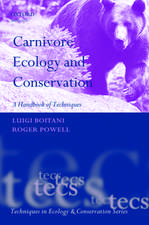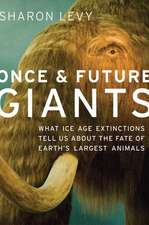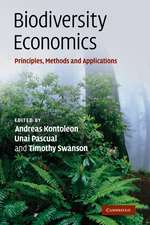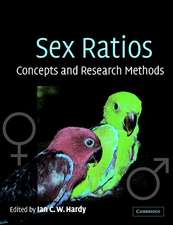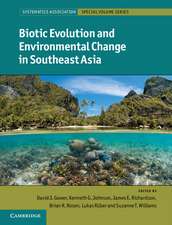Ecology of Atlantic Salmon and Brown Trout: Habitat as a template for life histories: Fish & Fisheries Series, cartea 33
Autor Bror Jonsson, Nina Jonssonen Limba Engleză Hardback – 6 mai 2011
The abundance of wild Atlantic salmon populations has declined in recent years; climate change and escaped farmed salmon are major threats. The climate influences through changes in temperature and flow, while escaped farmed salmon do so through ecological competition, interbreeding and the spreading of contagious diseases. The authors pinpoint essential problems and offer suggestions as to how they can be reduced. In this context, population enhancement, habitat restoration and management are also discussed. The text closes with a presentation of what the authors viewas major scientific challenges in ecological research on these species.
| Toate formatele și edițiile | Preț | Express |
|---|---|---|
| Paperback (1) | 1988.00 lei 39-44 zile | |
| SPRINGER NETHERLANDS – 23 aug 2016 | 1988.00 lei 39-44 zile | |
| Hardback (1) | 2494.20 lei 6-8 săpt. | |
| SPRINGER NETHERLANDS – 6 mai 2011 | 2494.20 lei 6-8 săpt. |
Din seria Fish & Fisheries Series
- 18%
 Preț: 1116.09 lei
Preț: 1116.09 lei - 18%
 Preț: 978.12 lei
Preț: 978.12 lei - 18%
 Preț: 1242.66 lei
Preț: 1242.66 lei - 18%
 Preț: 1223.74 lei
Preț: 1223.74 lei - 18%
 Preț: 1224.85 lei
Preț: 1224.85 lei - 18%
 Preț: 942.76 lei
Preț: 942.76 lei - 18%
 Preț: 1233.06 lei
Preț: 1233.06 lei - 15%
 Preț: 647.40 lei
Preț: 647.40 lei - 18%
 Preț: 2490.41 lei
Preț: 2490.41 lei - 18%
 Preț: 1239.19 lei
Preț: 1239.19 lei - 24%
 Preț: 1301.39 lei
Preț: 1301.39 lei - 18%
 Preț: 2099.91 lei
Preț: 2099.91 lei - 15%
 Preț: 650.19 lei
Preț: 650.19 lei - 18%
 Preț: 1837.88 lei
Preț: 1837.88 lei - 18%
 Preț: 1227.21 lei
Preț: 1227.21 lei - 18%
 Preț: 1230.84 lei
Preț: 1230.84 lei - 18%
 Preț: 947.35 lei
Preț: 947.35 lei - 18%
 Preț: 961.86 lei
Preț: 961.86 lei - 18%
 Preț: 1234.00 lei
Preț: 1234.00 lei - 18%
 Preț: 1226.11 lei
Preț: 1226.11 lei - 18%
 Preț: 1224.99 lei
Preț: 1224.99 lei - 18%
 Preț: 1234.00 lei
Preț: 1234.00 lei - 18%
 Preț: 1234.62 lei
Preț: 1234.62 lei - 15%
 Preț: 716.15 lei
Preț: 716.15 lei - 18%
 Preț: 1236.19 lei
Preț: 1236.19 lei - 18%
 Preț: 975.73 lei
Preț: 975.73 lei - 18%
 Preț: 1229.91 lei
Preț: 1229.91 lei - 18%
 Preț: 995.34 lei
Preț: 995.34 lei - 18%
 Preț: 1233.20 lei
Preț: 1233.20 lei - 18%
 Preț: 1230.66 lei
Preț: 1230.66 lei
Preț: 2494.20 lei
Preț vechi: 3041.71 lei
-18% Nou
Puncte Express: 3741
Preț estimativ în valută:
477.49€ • 498.21$ • 400.26£
477.49€ • 498.21$ • 400.26£
Carte tipărită la comandă
Livrare economică 13-27 martie
Preluare comenzi: 021 569.72.76
Specificații
ISBN-13: 9789400711884
ISBN-10: 9400711883
Pagini: 690
Ilustrații: XXII, 708 p.
Dimensiuni: 155 x 235 x 38 mm
Greutate: 1.13 kg
Ediția:2011
Editura: SPRINGER NETHERLANDS
Colecția Springer
Seria Fish & Fisheries Series
Locul publicării:Dordrecht, Netherlands
ISBN-10: 9400711883
Pagini: 690
Ilustrații: XXII, 708 p.
Dimensiuni: 155 x 235 x 38 mm
Greutate: 1.13 kg
Ediția:2011
Editura: SPRINGER NETHERLANDS
Colecția Springer
Seria Fish & Fisheries Series
Locul publicării:Dordrecht, Netherlands
Public țintă
ResearchCuprins
Preface
Habitats as template for life histories
Species diversity
Habitat use
Development and Growth
Smolts and smolting
Migrations
Maturation and spawning
Recruitment, mortality and longevity
Climatic effects on Atlantic salmon and brown trout
Farmed Atlantic salmon in nature
Population enhancement and population restoration
General conclusions and research tasks
Glossary
Species Index
Author Index
Subject Index
Habitats as template for life histories
Species diversity
Habitat use
Development and Growth
Smolts and smolting
Migrations
Maturation and spawning
Recruitment, mortality and longevity
Climatic effects on Atlantic salmon and brown trout
Farmed Atlantic salmon in nature
Population enhancement and population restoration
General conclusions and research tasks
Glossary
Species Index
Author Index
Subject Index
Recenzii
From the reviews:
“This book brings together a tremendous amount of material … on Atlantic salmon and brown trout in a well-organized manner, producing a book that is both thorough and accessible. … There is no doubt that this book has hit the mark with respect to graduate students and working scientists. … those obtaining it will find it full of information about past research and ideas for future work.” (Thomas P. Quinn, Reviews in Fish Biology and Fisheries, Vol. 22, 2012)
“This book brings together a tremendous amount of material … on Atlantic salmon and brown trout in a well-organized manner, producing a book that is both thorough and accessible. … There is no doubt that this book has hit the mark with respect to graduate students and working scientists. … those obtaining it will find it full of information about past research and ideas for future work.” (Thomas P. Quinn, Reviews in Fish Biology and Fisheries, Vol. 22, 2012)
Textul de pe ultima copertă
Destruction of habitat is the major cause for loss of biodiversity including variation in life history and habitat ecology. Each species and population adapts to its environment, adaptations visible in morphology, ecology, behaviour, physiology and genetics. Here, the authors present the population ecology of Atlantic salmon and brown trout and how it is influenced by the environment in terms of growth, migration, spawning and recruitment. Salmonids appeared as freshwater fish some 50 million years ago. Atlantic salmon and brown trout evolved in the Atlantic basin, Atlantic salmon in North America and Europe, brown trout in Europe, Northern Africa and Western Asia. The species live in small streams as well as large rivers, lakes, estuaries, coastal seas and oceans, with brown trout better adapted to small streams and less well adapted to feeding in the ocean than Atlantic salmon. Smolt and adult sizes and longevity are constrained by habitat conditions of populations spawning in small streams. Feeding, wintering and spawning opportunities influence migratory versus resident lifestyles, while the growth rate influences egg size and number, age at maturity, reproductive success and longevity. Further, early experiences influence later performance. For instance, juvenile behaviour influences adult homing, competition for spawning habitat, partner finding and predator avoidance.
The abundance of wild Atlantic salmon populations has declined in recent years; climate change and escaped farmed salmon are major threats. The climate influences through changes in temperature and flow, while escaped farmed salmon do so through ecological competition, interbreeding and the spreading of contagious diseases. The authors pinpoint essential problems and offer suggestions as to how they can be reduced. In this context, population enhancement, habitat restoration and management are also discussed. The text closes with a presentation of what the authors view as majorscientific challenges in ecological research on these species.
The abundance of wild Atlantic salmon populations has declined in recent years; climate change and escaped farmed salmon are major threats. The climate influences through changes in temperature and flow, while escaped farmed salmon do so through ecological competition, interbreeding and the spreading of contagious diseases. The authors pinpoint essential problems and offer suggestions as to how they can be reduced. In this context, population enhancement, habitat restoration and management are also discussed. The text closes with a presentation of what the authors view as majorscientific challenges in ecological research on these species.
Caracteristici
A modern reference to the ecology of Atlantic salmon and brown trout with intraspecific and interspecific comparisons First synthesis of the close relationship between habitat and life histories of these species Wide description of how salmonid populations are influenced by climate change and escape from salmon farms and how populations can be managed to reduce negative environmental impacts




